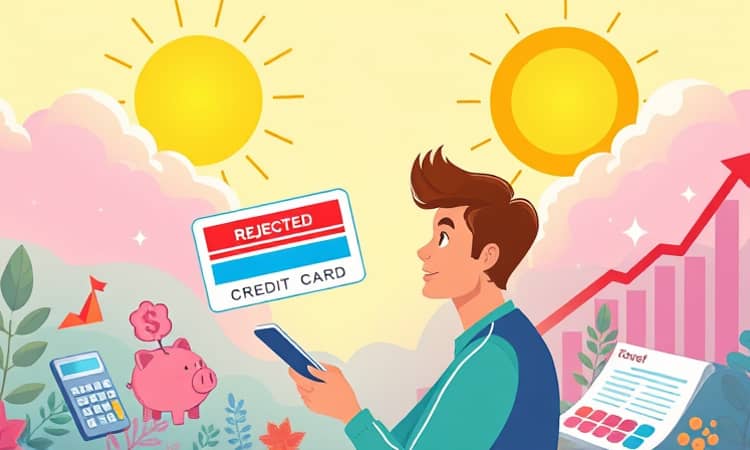Credit Card Rejection: 5 Ways to Bounce Back

Dealing with credit card rejection can be disheartening, especially if you were counting on that card for purchases or to build your credit history. However, it’s important to remember that this setback can serve as an opportunity to improve your financial health. Understanding the factors that led to your rejection and taking actionable steps can prepare you for future successes.
In this article, we will explore five effective ways to bounce back from a credit card rejection. We will cover understanding the reasons behind the rejection, checking your credit score, improving your credit score, considering secured credit cards, and reapplying with a different card. Each step will provide you with valuable information and tips to help strengthen your financial profile.
By following these steps, you can enhance your creditworthiness, which may lead to approval for the credit that you desire in the future. Let’s dive into the details of how to turn this setback into a comeback.
Understand Why You Were Rejected

Getting a credit card rejection can be perplexing, especially if you feel you have maintained a healthy financial profile. The first step in moving forward is to understand the rationale behind the rejection. Credit card companies have their own criteria for evaluating applications, which can vary significantly from one lender to another.
Common reasons for rejection include a low credit score, a lack of credit history, high levels of existing debt, or discrepancies in your application information. Knowing the precise reasons will not only help you rectify those issues but also give you insight into what lenders are looking for.
- Low credit score
- Lack of credit history
- High debt-to-income ratio
- Recent late payments
- Errors on your credit report
Understanding the specific reasons for your rejection is crucial. Once you have this information, you can formulate a plan to address those weaknesses and improve your chances of approval in the future.
Check Your Credit Score

Checking your credit score is a vital component of understanding your financial standing. Many consumers are surprised to learn what their credit score really is, as it may not always align with their expectations. By obtaining a copy of your credit report, you can gain insights into the factors impacting your score, including payment history and credit utilization.
Identifying your current credit score allows you to address areas that need improvement. You can access your credit report for free once a year from the major credit bureaus, giving you the opportunity to monitor your score regularly and stay informed about your credit health.
- Obtain your credit report from the major credit bureaus
- Review your payment history for accuracy
- Check for any outstanding debts or collections
- Assess your credit utilization ratio
- Identify any errors that could be impacting your score
Once you have reviewed your credit report and identified your score, you’ll know where you stand. This information is essential for targeting areas that require improvement and preparing for another credit application. Understanding your credit score allows you to set realistic goals and timelines for enhancing your creditworthiness.
Improve Your Credit

Improving your credit score may take some time, but it is an achievable goal. Start by addressing any negative items on your credit report, such as overdue payments or defaults. Making timely payments moving forward is crucial, as payment history is one of the most significant factors affecting your score.
Furthermore, maintaining a low credit utilization ratio – ideally under 30% of your available credit – can significantly enhance your score. It shows lenders that you are responsible with your credit usage, indicating a lower risk for them.
- Pay your bills on time
- Reduce existing debt
- Keep credit card balances low
- Avoid opening new credit accounts before reapplying
- Limit hard inquiries on your credit report
As your credit improves, so does your chances of being approved for a credit card. Regularly monitoring your progress can keep you motivated, and it allows you to see firsthand the positive effects of your efforts on your credit score. With increased awareness and intentional steps toward your financial goals, you'll be in a stronger position when you decide to apply again.
Consider a Secured Credit Card

If your credit score is significantly low, a secured credit card can serve as a practical option for rebuilding your credit. Secured credit cards require a cash deposit that acts as your credit limit. This small security deposit lowers the risk for the lender, making it easier for individuals to get approved even with a poor credit history.
Using a secured credit card responsibly can lead to improvements in your credit score, especially if you make payments on time and keep balances low. It’s a great way to demonstrate your creditworthiness to lenders while simultaneously building or enhancing your credit profile.
- Deposit a cash amount to secure your credit limit
- Make purchases and keep your balance under 30%
- Pay your bills on time to establish a positive payment history
- Monitor your credit score to track improvements
- Consider transitioning to an unsecured card after 6-12 months of responsible use
Once you have established a history of responsible credit use with a secured card, you will be in a stronger position to apply for an unsecured credit card. Remember that the key to this approach is consistency and maintaining healthy financial habits.
Reapply with a Different Card

After understanding why you were rejected and taking the necessary steps to improve your credit profile, the next move is to reapply for a credit card. However, it's essential to do so strategically. This means researching different credit cards that align with your current financial standing and goals. By targeting cards that cater to your specific credit situation, you increase your chances of approval.
Utilize comparison websites or tools that allow you to filter credit cards by credit score requirements, fees, and benefits. This targeted approach will save you time and reduce the chances of further rejections, as applying for cards that you qualify for can streamline the process.
Finally, consider waiting a few months before you apply again if you received multiple rejections in a short period. This careful consideration will ensure that your credit score isn’t negatively impacted by hard inquiries, which can occur when lenders check your score during the application process.
Final Thoughts

Credit card rejection can feel like a setback, but it can also pave the way for significant financial growth. By understanding the reasons behind your rejection, checking your credit score, and taking steps to improve it, you can enhance your chances of future approval. Secured credit cards and strategic reapplications can be effective ways to gradually rebuild your credit history.






